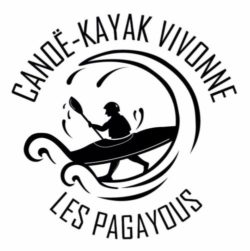English translation of our « Nautical trails » signs
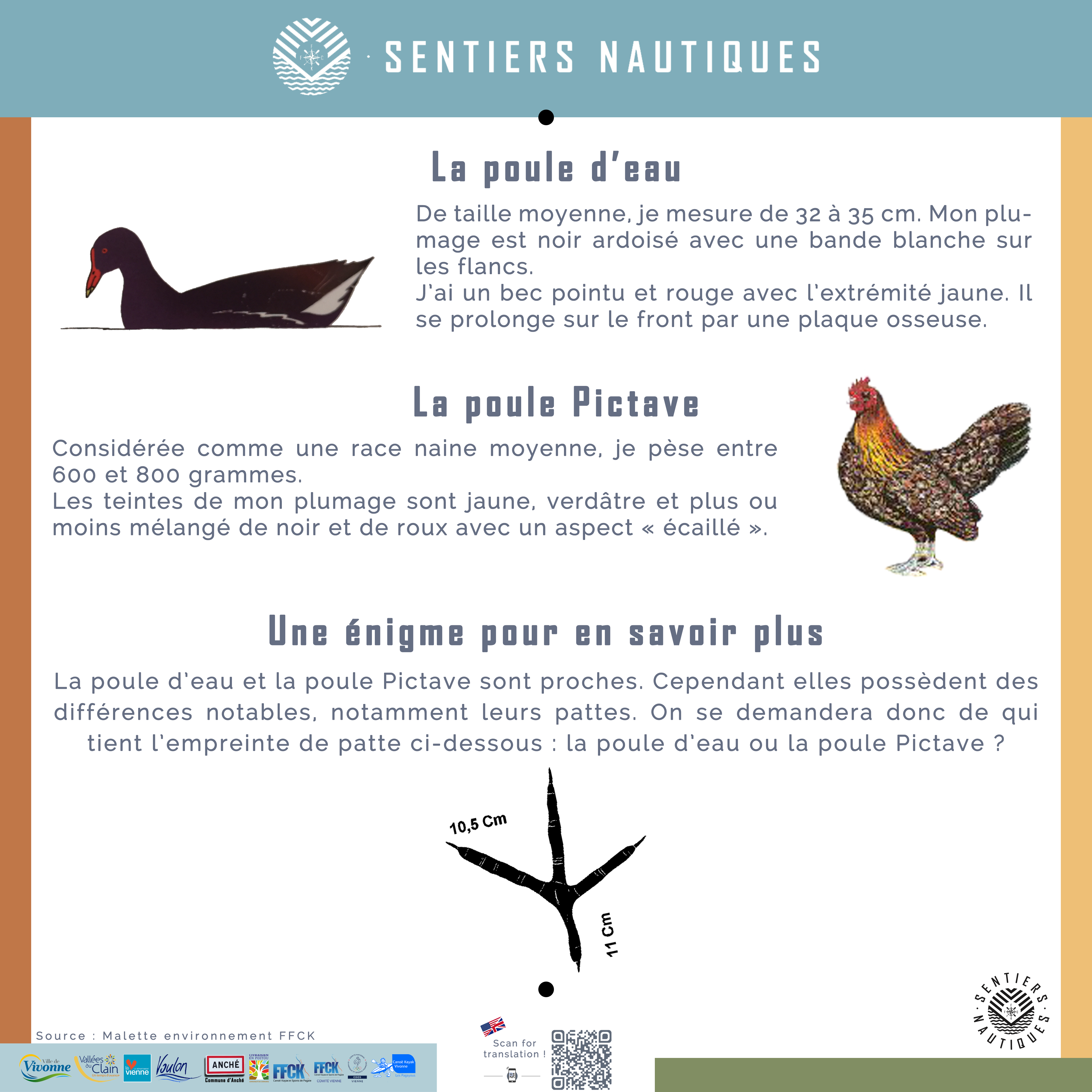
The water hen
On average I measure from 32 to 35 centimetres. My feathers are slate black with a white stripe on the sides. I have a red pointed beak with a yellow tip. It is extended over my forehead by a bony plate.
The Pictavian hen
Considered as a normal dwarf breed, I weigh between 600 and 800 grams. The shading of my feathers is yellow and greenish, along with a reddish black shade with a scaly appearance.
A puzzle to learn more
The water hen and the Pictavian hen are closely related. However, they have notable differences, especially their legs. So we need to ask ourselves who the paw print below comes from: the water hen or the Pictavian hen?
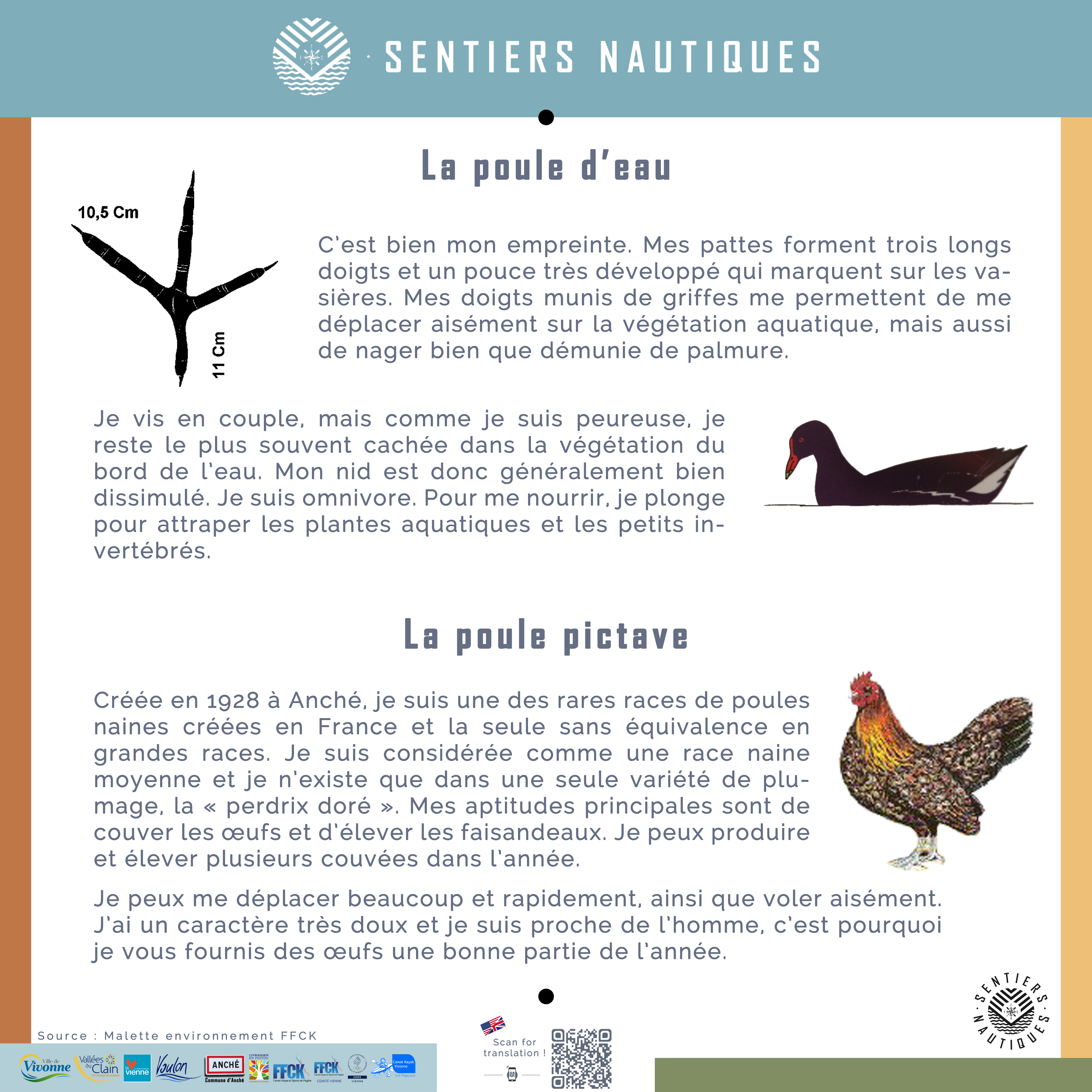
This is indeed my footprint !
This is the footprint of the water hen. My feet have three long fingers and a very developed thumb that shows clearly on the mudflats. My fingers with claws allow me to move easily on the aquatic vegetation, but also to swim even though I don’t have webbed fingers.
I live as a couple, but because I am shy, I usually stay hidden in the vegetation at the water’s edge. My nest is therefore generally well hidden. I am omnivorous, I dive to feed on aquatic plants and small invertebrates.
The Pictavian hen
Created in 1928 in Anché, I’m one of the rare breeds of dwarf hens created in France and the only one without a matching large breed. I am considered a standard dwarf breed and I only have one form of plumage, the “golden partridge”. My main abilities are to incubate my eggs and to raise my chicks. I can produce and raise several broods in a year.
I can move far and quickly and I fly with ease. I have a very gentle character and I am close to humans, that’s why I provide you with eggs a good part of the year.
What is a watershed?
A watershed is an area that enables all water to be drained to a common outlet, river or sea. In this case, the Clain flows into another river, the Vienne, which is called the confluence. A watershed includes a main river (the Clain), fed by streams and springs which are its tributaries. This chain of rivers interacts closely with wetlands and groundwater which increase the river’s flow in summer or winter and at other times feed the river.
A puzzle to help you learn more
In canoeing or when we travel on water in general, we use the following terms: upstream/downstream. Do you know the difference?
Hints
I am located closer to the mouth of a river and I am at a low altitude. What am I?
I am located further away from the source of a river and I am at a higher altitude. What am I?
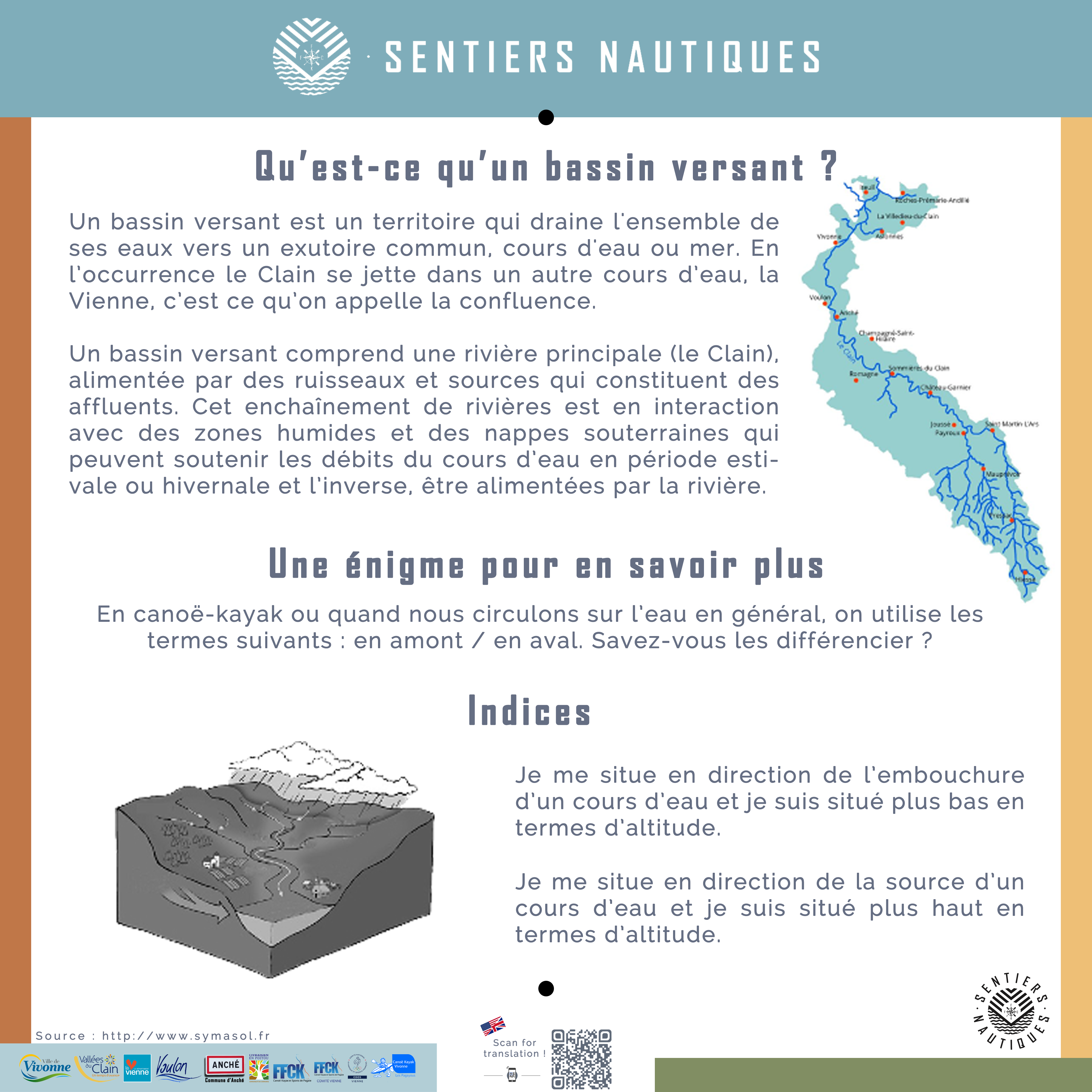
Upstream / downstream
In order to tell the difference you need to observe the direction of the current
“Upstream” I am the part of the river that is before a given point. Going upstream means going up the stream and heading towards the source.
“Downstream” is the part of the stream that is after a given point. Going downstream means going in the direction of the current and towards the mouth of the stream.
To know more about it …
Anything done upstream has an impact downstream, which means that an increase in the number of small disturbances can lead to damage in the whole river basin. These disturbances can be related to human or environmental activity. For example, a flood due to heavy rainfall upstream will increase the water level downstream.
Disturbances linked to human activity can have serious consequences. Waste dumped upstream of a watercourse can impede water flow and promote bank degradation. It can also dissolve into fine particles, causing water pollution and disturbing flora and fauna.
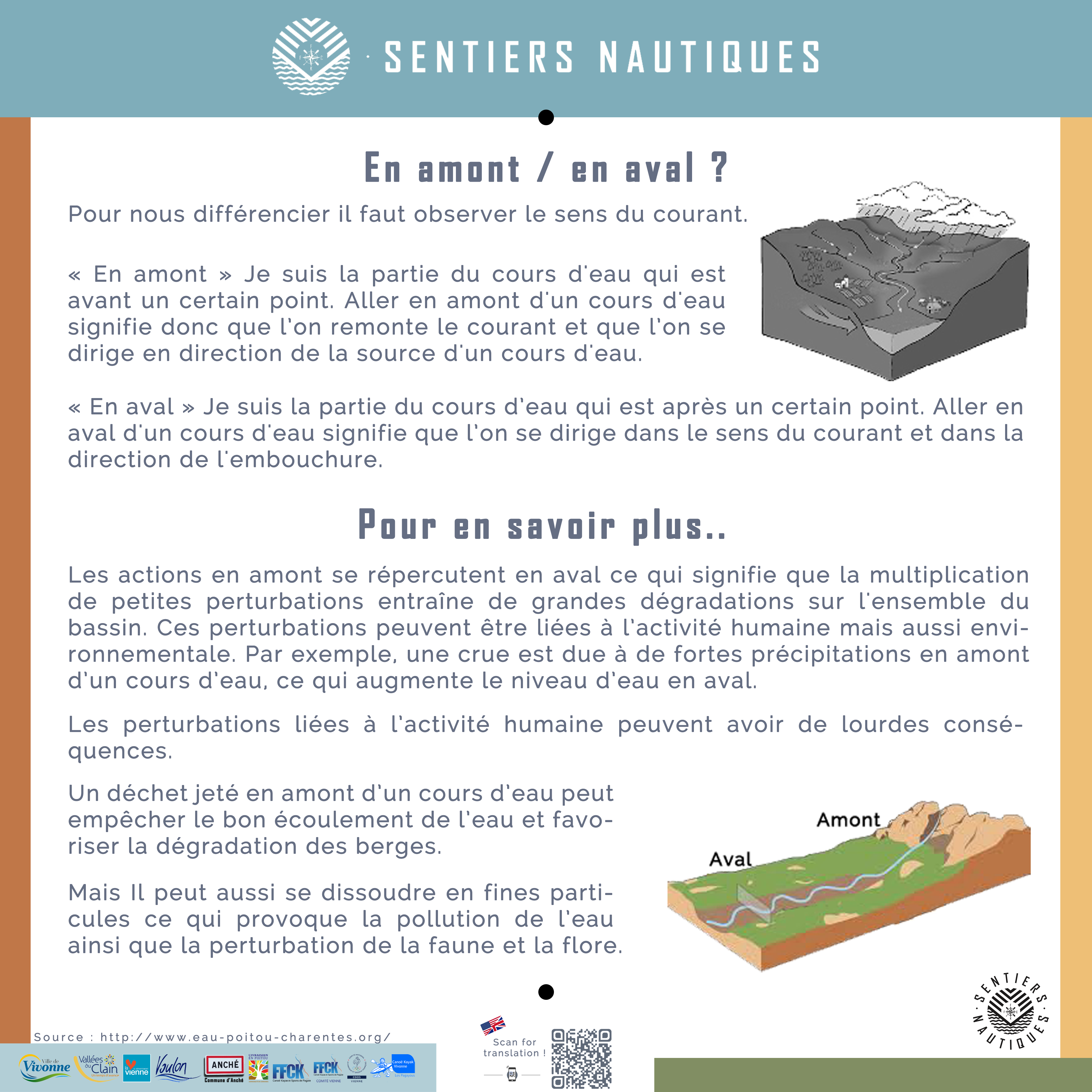
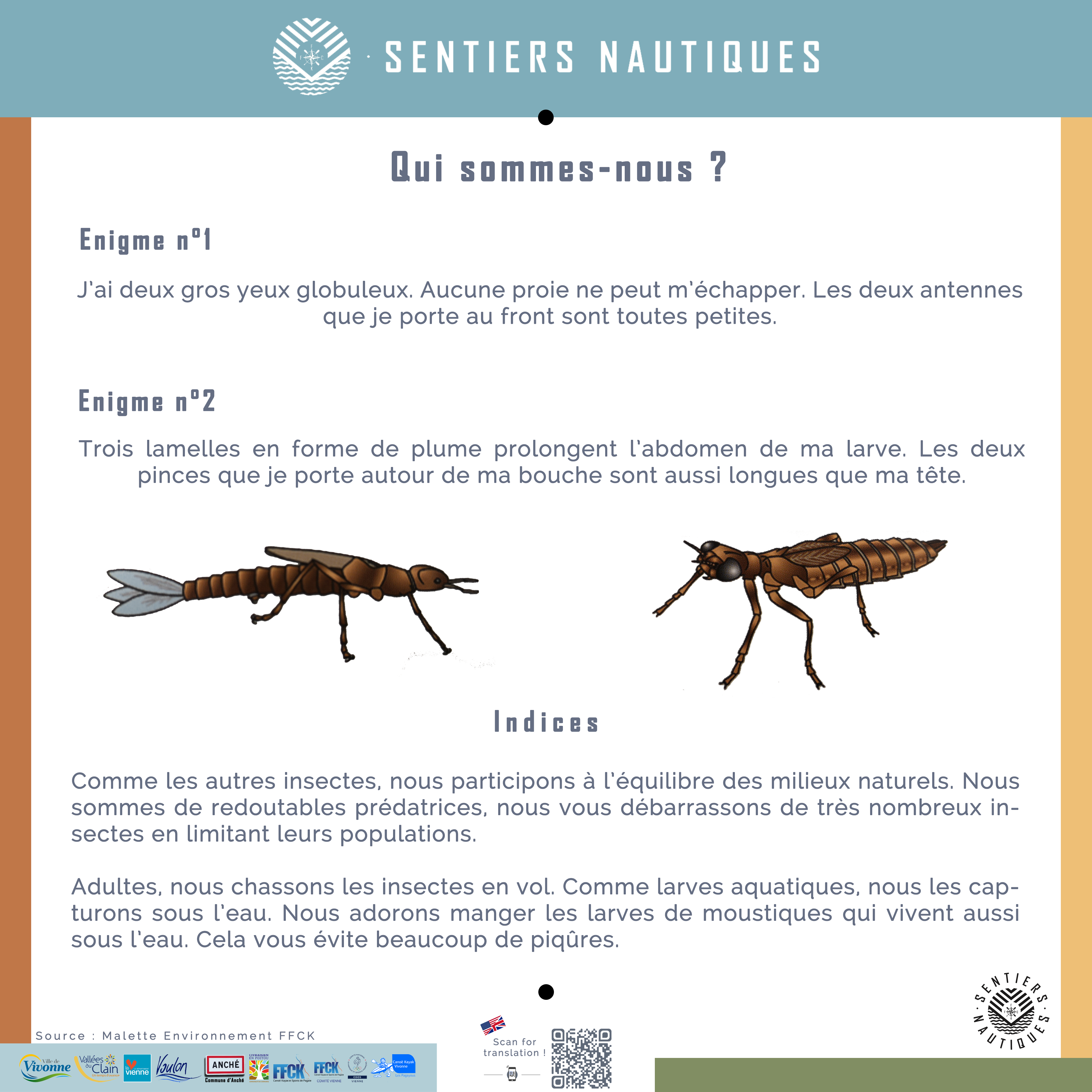
Who are we ?
Riddle n°1
I have two big bulging eyes, no prey can escape me. The two antennae that I have on my forehead are very small.
Riddle n°2
Three feather-shaped strips extend along the abdomen of my larva. The two claws around my mouth are as long as my head.
Hints
Like other insects, we support the balance of natural environments. We are fearsome predators, we get rid of many insects by limiting their populations.
As adults, we hunt insects in flight and capture aquatic larvae underwater. We love to eat mosquito larvae that also live underwater. This saves you from a lot of bites.
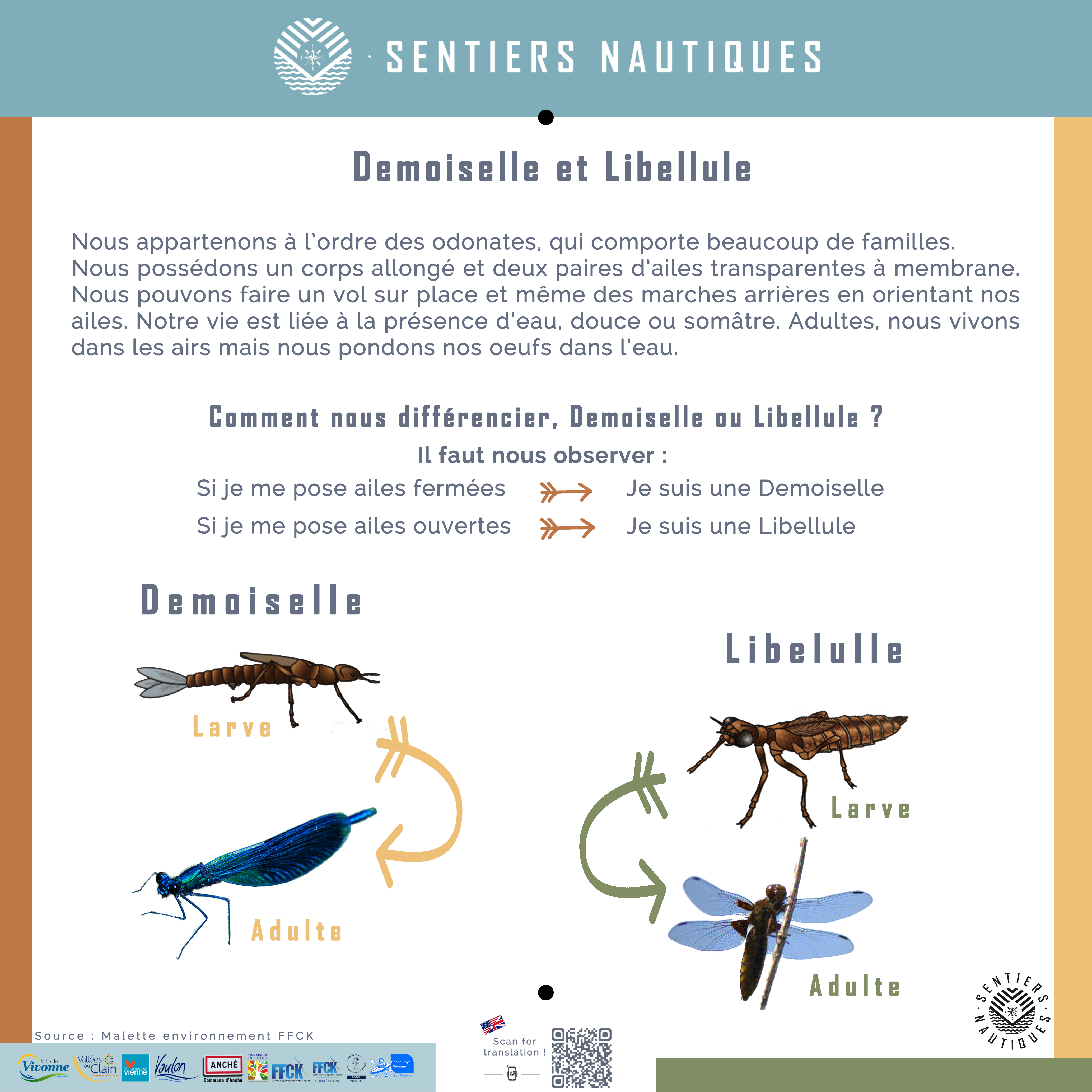
Damselfy and dragonfly
We belong to the order of the odonates, which has many families. We have an elongated body and two pairs of transparent membrane wings. We can take flight on the spot and even fly backwards by turning our wings. Our life depends on the presence of water, fresh or salty. As adults, we live in the air but we lay our eggs in the water.
How to differentiate us, damselfly or dragonfly?
You need to look closely:
If I land with my wings closed –> I am a damselfly.
If I land with open wings –> I am a dragonfly
Alder and ash trees
We are brothers and we live along the banks of the Clain. We help to form what is known as the ripisylve, which is the wooded, bushy and herbaceous area on the banks of a watercourse. When fully grown, our trunks can be the same width for more than 20 metres in height. You can tell us apart by the colour of our wood. One of us has whitish wood, the other has red wood although pinkish when freshly cut, but these colours don’t persist in the light.
Can you recognise us?
Oval leaf, truncated at the top. Dark green glossy and sticky upper side. Underside matted with angel hair tufts on the veins.
Leaf composed of 5 to 15 opposite leaflets. Upper side dark green and smooth. Lower side lighter, with veins and slightly hairy.
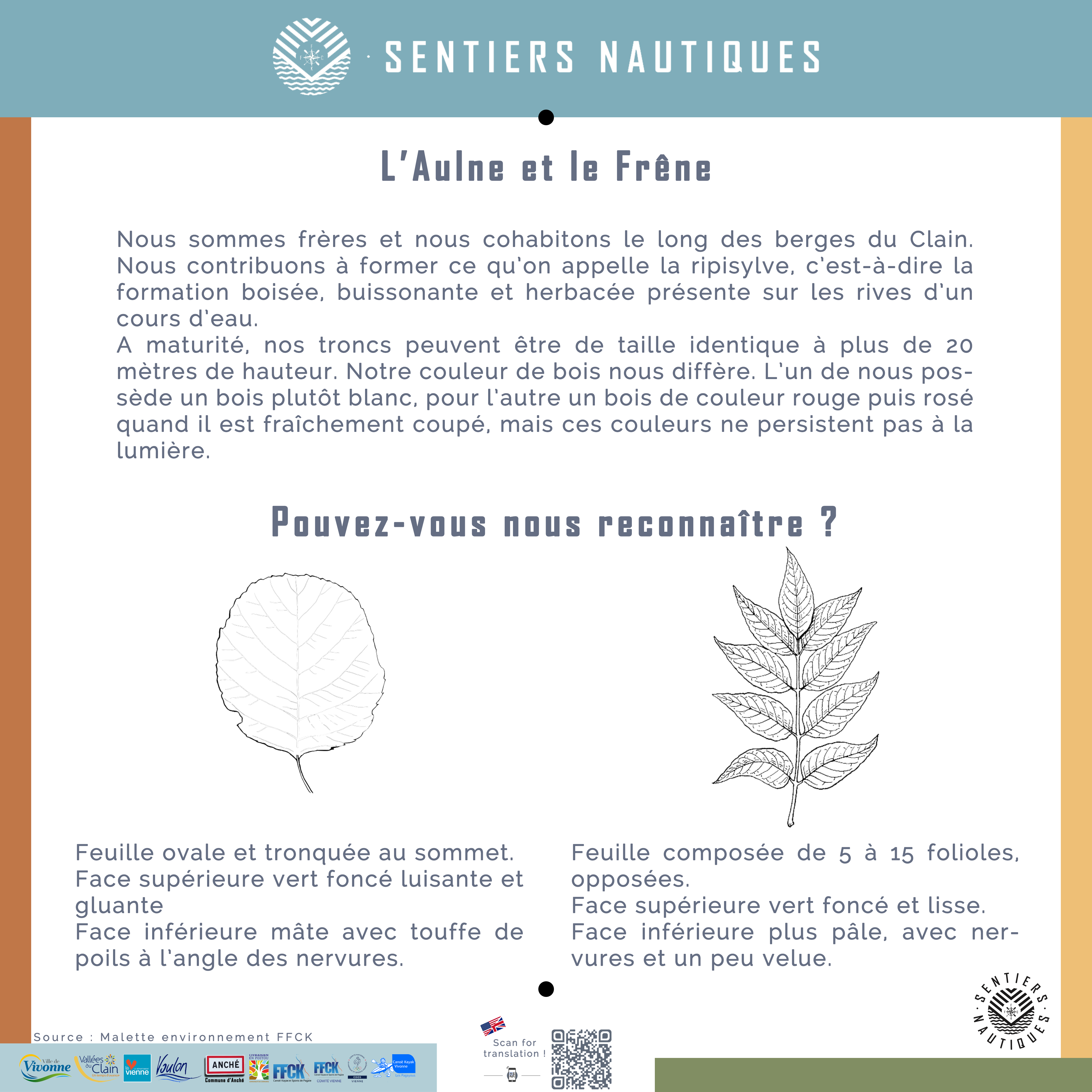
The alder
I am the common alder, also known as the black alder. Here, I am known as the “Vergne”. I am very often found on the riverside. Thanks to my deep root system, I am effective in supporting the river banks. All year round I have small dark brown cones called “strobiles” which allow me to reproduce myself. My wood is light, soft and fragile out of the water. But underwater, I am rot-proof and I am used for pontoon piles or house foundations like in Venice.
The ash tree
I am a tree with a straight, slender trunk and greenish-grey bark. My fruits are called “samares” and ripen in elongated clusters. My seed is surrounded by a flattened wing which flies in the wind. My leaves and fruit have medicinal virtues, especially against rheumatism. My hardwood is flexible. It is used to make tool handles and, in the past, spear shafts. When it is cold, I help you to warm up, when you put me in the fireplace.
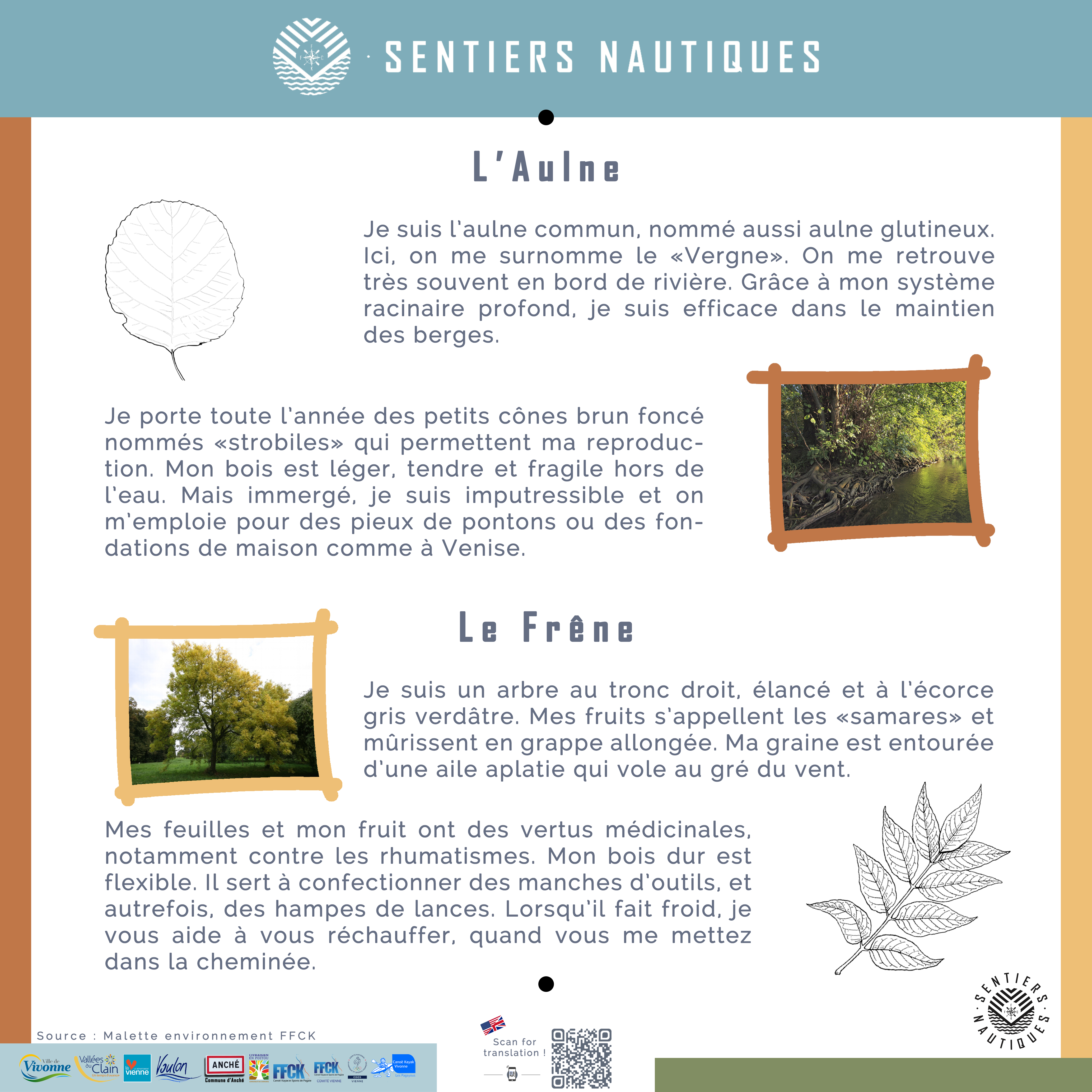
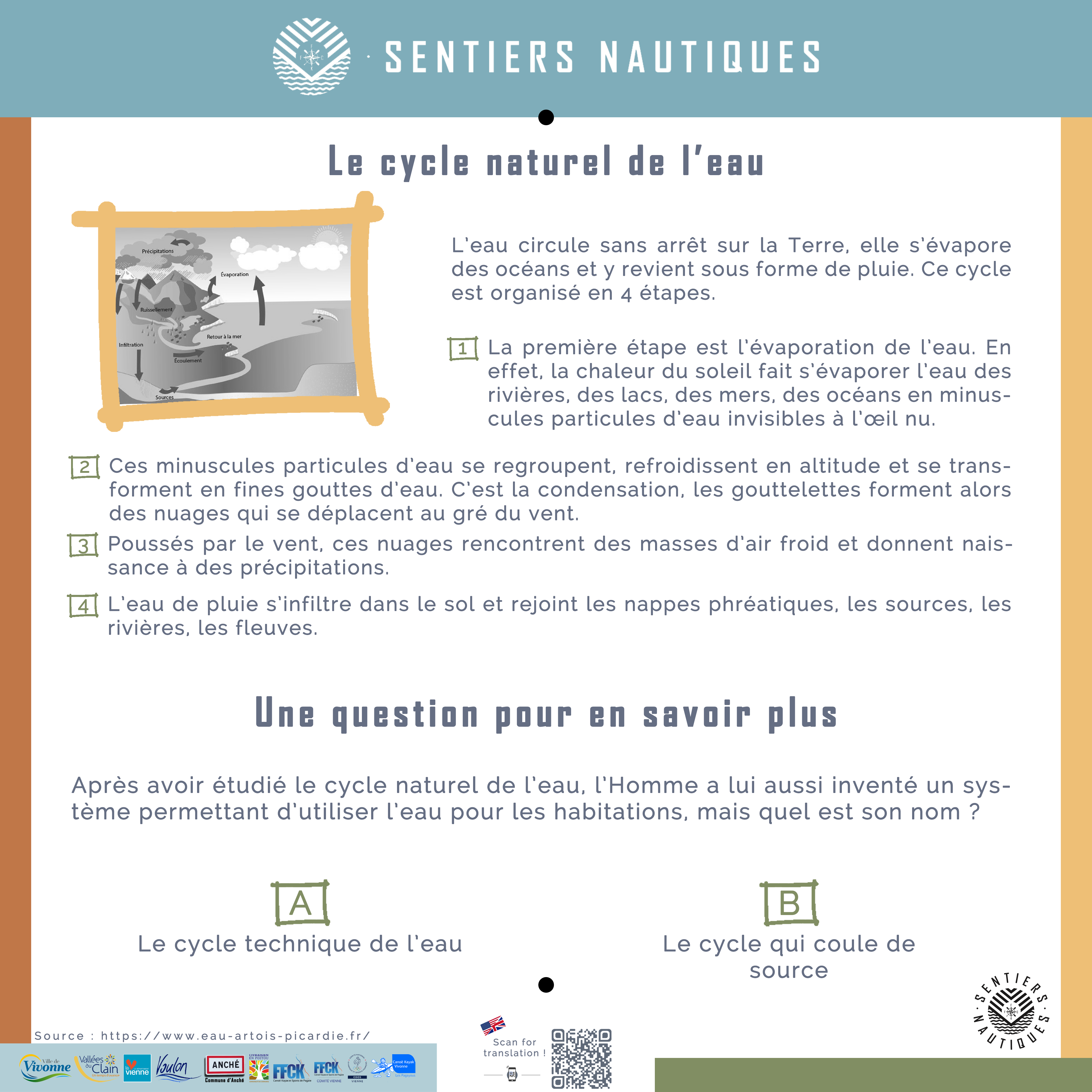
The natural water cycle
On planet earth, water circulates non-stop, evaporating from the oceans and returning to them as rain. This cycle has 4 stages.
– The first stage is the evaporation of water. The heat of the sun evaporates water from rivers, lakes, seas and oceans into tiny water particles invisible to the naked eye.
– These tiny water particles gather together, cool down as they rise and turn into fine drops of water. This is called condensation, these droplets then form clouds which move with the wind.
– Pushed by the wind, these clouds meet cold air masses which causes precipitation.
– The rainwater soaks into the ground and reaches the water tables, springs and rivers.
A question to learn more
By learning from the natural water cycle, man has also invented a system that allows us to have water in our homes, but what is its name?
A – The urban water cycle
B – The hydrologic water cycle
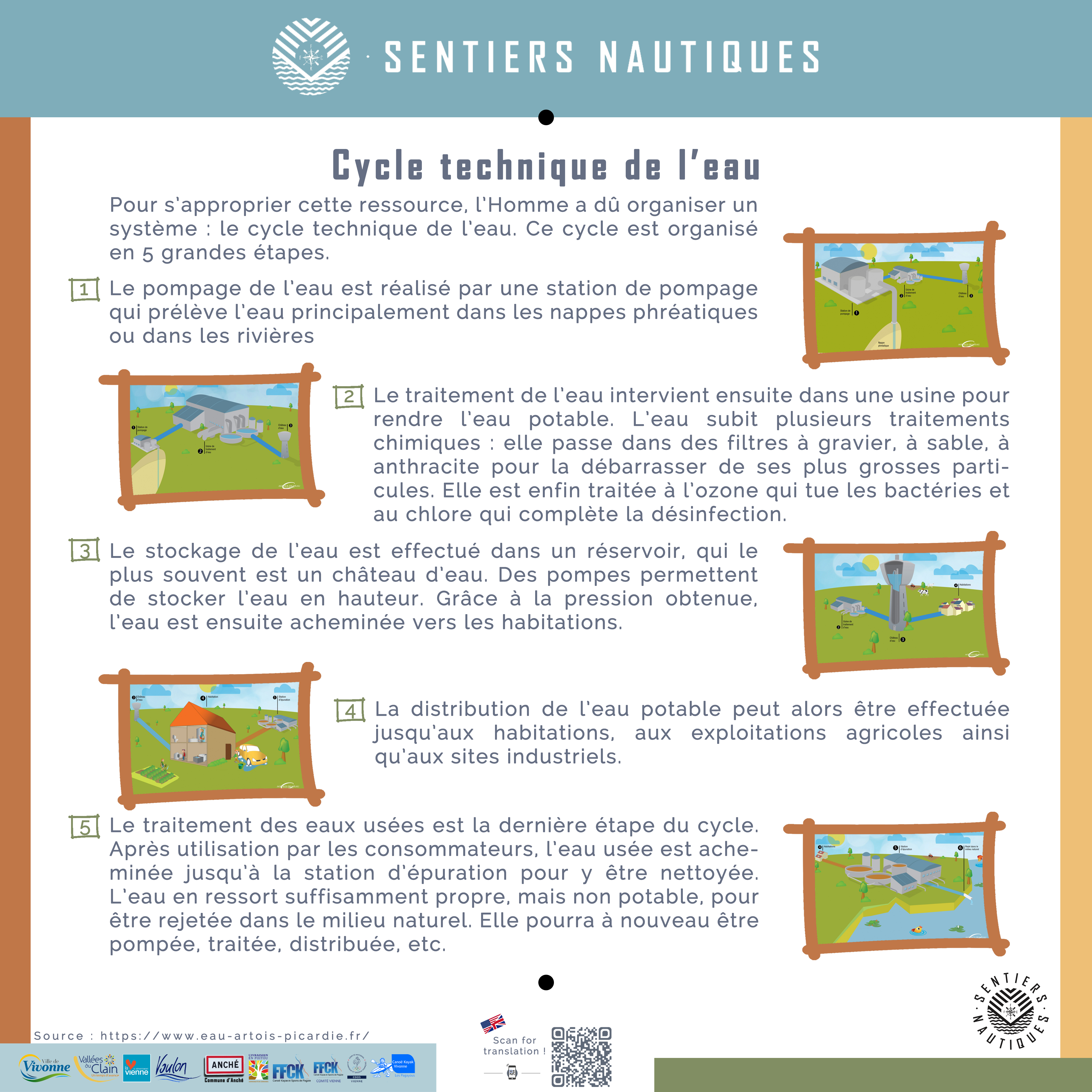
The urban water cycle
In order to take advantage of this resource, Man has had to establish a system: the urban water cycle. This cycle has 5 main stages.
– Water is pumped by a pumping station that draws water mainly from groundwater or rivers.
– Water treatment then takes place in a plant in order to make the water drinkable. The water undergoes several chemical treatments: it passes through gravel, sand and anthracite filters to remove its largest particles. Finally, it is treated with ozone, which kills bacteria, and chlorine, which completes the disinfection process.
– The water is stored in a tank, which is most often a water tower. Pumps are used to store the water high up. Thanks to the pressure obtained, the water is then conveyed to homes.
– Drinking water can then be distributed to homes, farms and industrial sites.
– Wastewater treatment is the last step in the cycle. After use by consumers, the wastewater is sent to the treatment plant for cleaning. The water leaves the plant sufficiently clean to be discharged into the natural environment, although it is not clean enough to be drunk. It can then be pumped, treated, distributed, … again and again.
The castle of Cercigny
The castle was built on oak stilts in the middle of the 14th century on an islet surrounded by a wide moat. Later, it was partially destroyed during the Hundred Years War and the Wars of Religion. It was then not inhabited until the 17th century, when its reconstruction began. The castle belonged to Françoise Athénaïs de Rochechouart, Marquise of Montespan and Louis XIV’s mistress.
Close to the castle, there is a dovecote. It is considered to be the largest in the Vienne with nearly 3050 pigeonholes. These fowl were mainly bred as a food supply for the castle’s owners. In addition to the dovecote, the castle also has a chapel. It remains today the only remaining example of 17th century rural art in the Vienne. Completed in 1626, it was built by Jeanne de Saux-Tavannes, a princess descended from the kings of Burgundy.
A question to learn more
In your opinion, why at that time were castles, including the castle of Cercigny, surrounded by a moat?
A : To be able to bathe and refresh oneself during hot periods
B : To prevent attacks and invasion attempts by the enemy
C : For the visual and aesthetic reasons
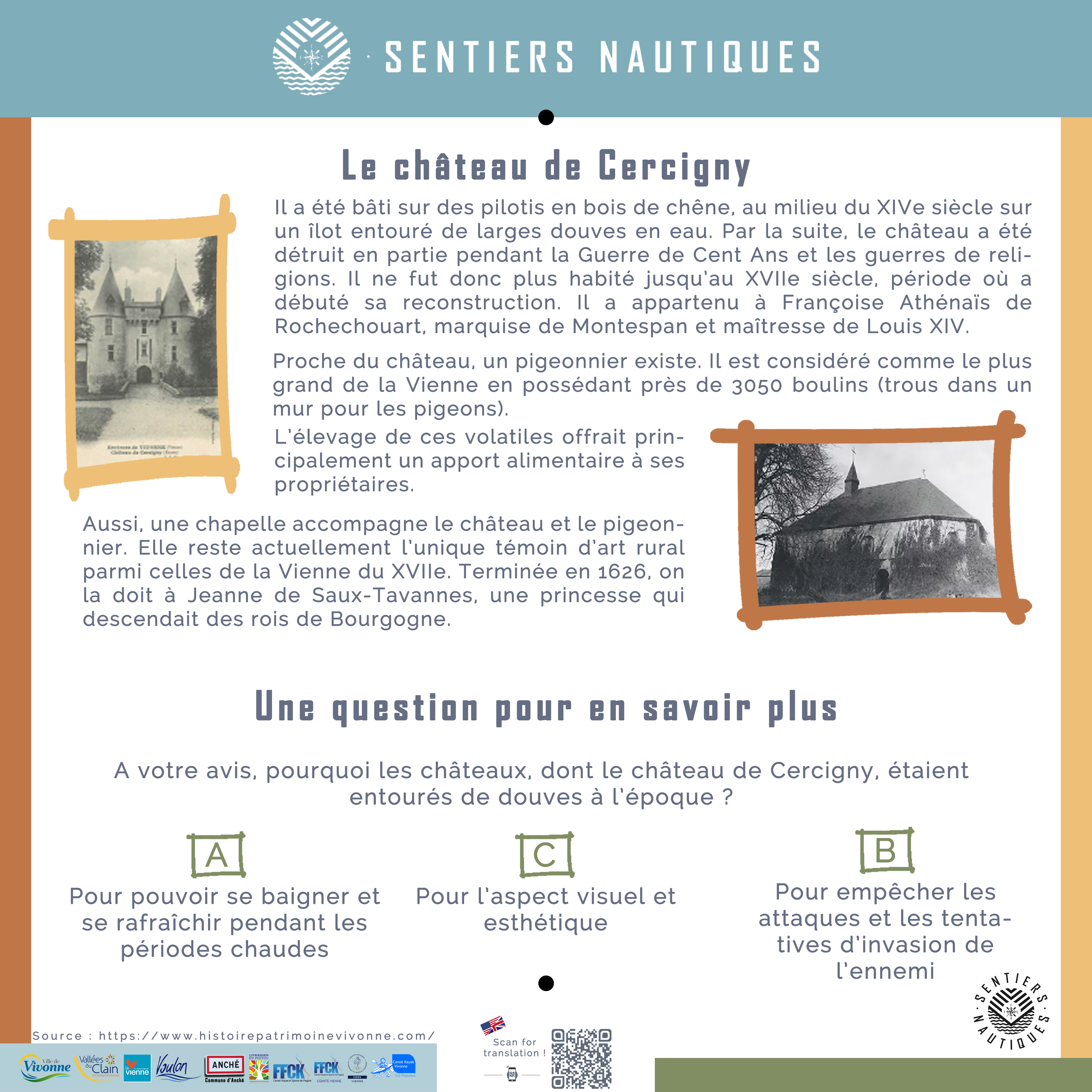
What was the moat for?
Moats were wide and deep ditches, mostly filled with water, surrounding castles, important buildings or fortified towns. They were dug to form an obstacle against enemy attack. This made the use of siege engines, such as towers or rams, against fortifications surrounded by moats difficult if not impossible.
Moats were filled by diverting water from a nearby stream, pond, or lake, as was the case with Cercigny Castle. Access to the interior of the enclosure was possible only via light bridges or drawbridges, for the larger fortifications. After the Renaissance, the moat continued to surround the castles for a purpose that became mainly aesthetic, as with Cercigny Castle.
The little extra info
Do you know where the French expression “se faire pigeonner” (to be taken for a ride) comes from?
Around the 16th century, the wealth of a lord was demonstrated by his pigeons. The quantity of pigeons had to be proportional to the amount of farmed land and therefore to the wealth of the lord. During marriages between noble families, the wealth of each one was determined by the number of pigeonholes in their dovecote. Sometimes, some unscrupulous lords would add false pigeonholes in their dovecote in order to marry their children. This fraudulent practice gave rise to the expression “se faire pigeonner”.
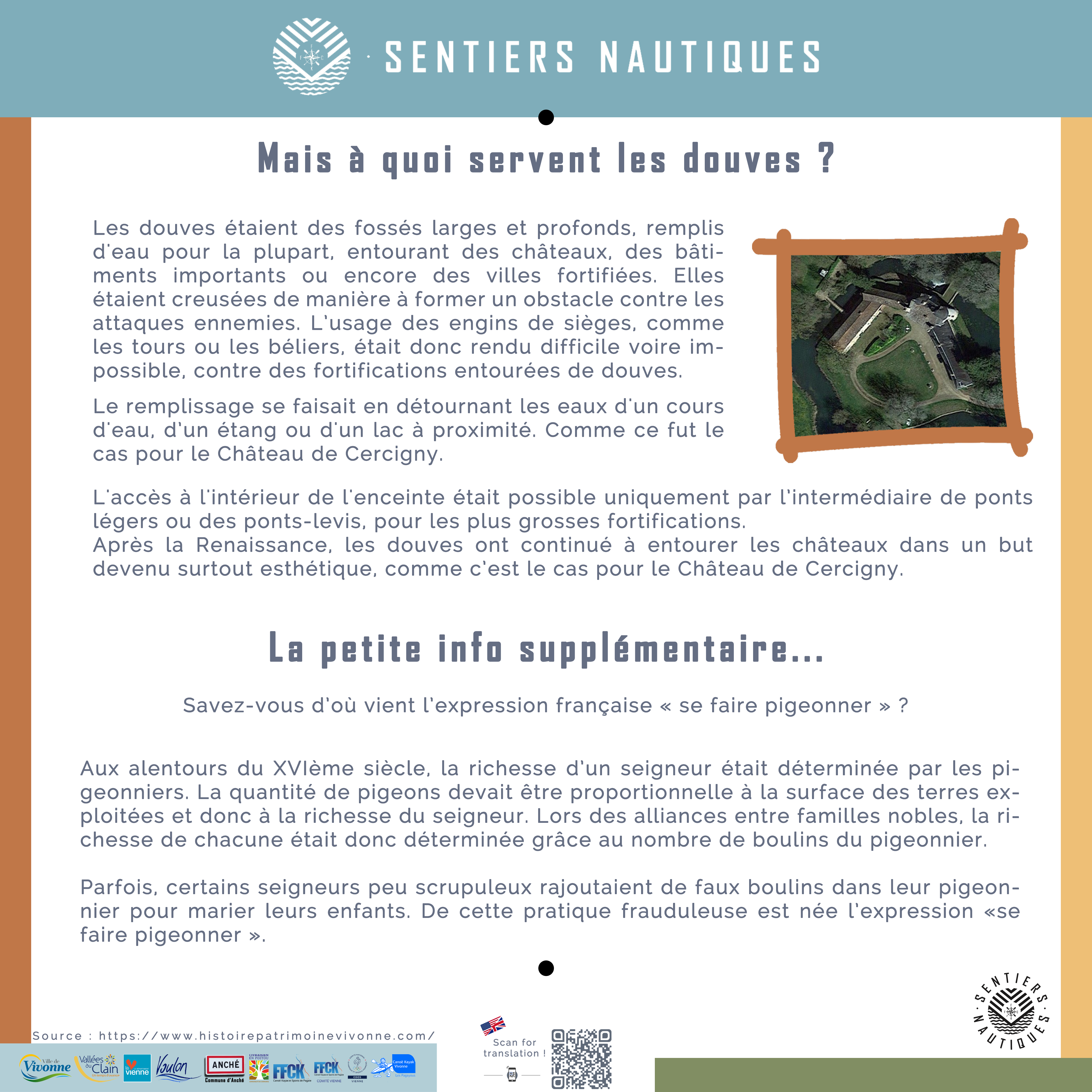
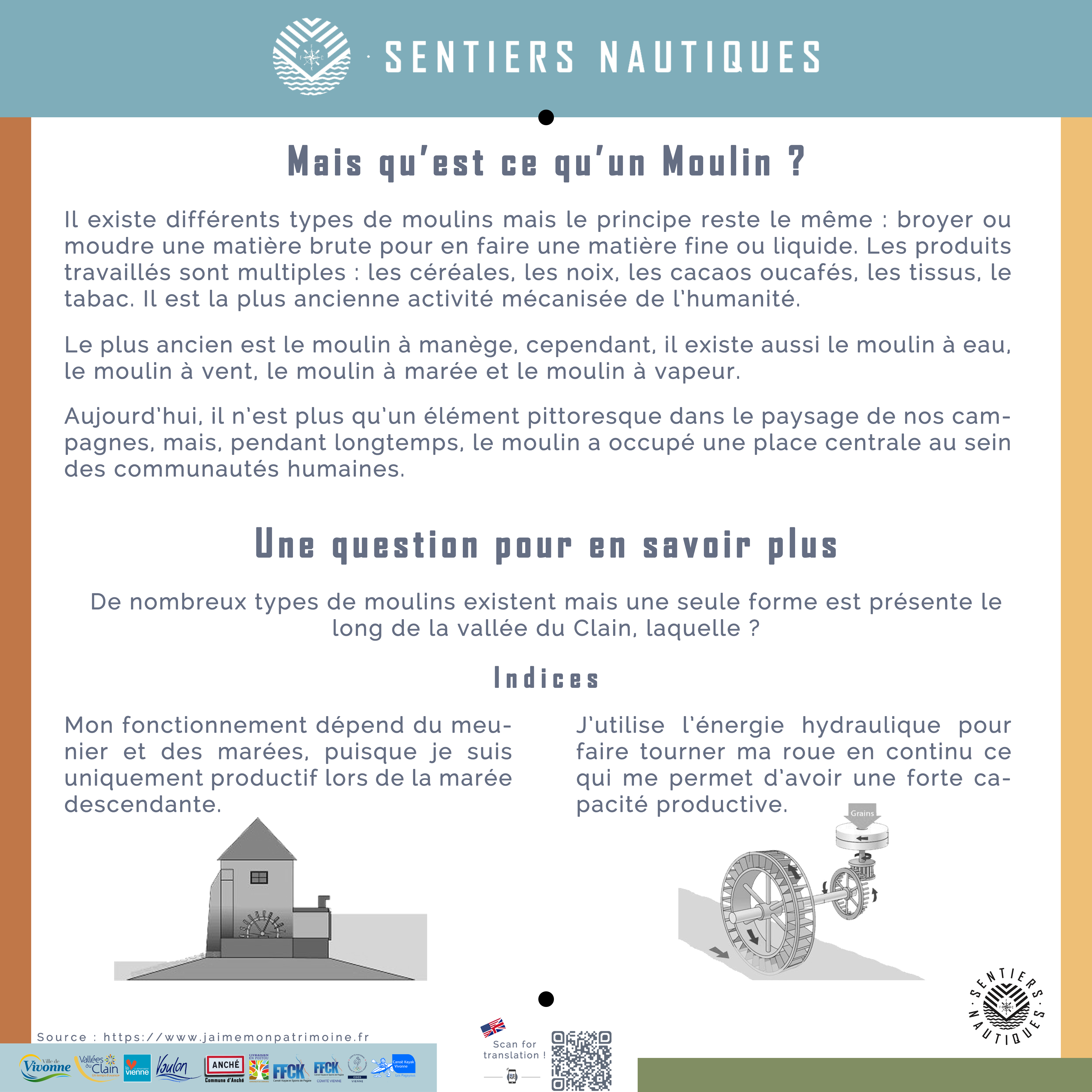
What is a mill?
There are different types of mills but the principle remains the same : they grind a raw material to make a fine material or a liquid. The products processed are numerous: cereals, nuts, cocoa or coffee, fabrics, tobacco. The mill is the oldest mechanised human activity. The oldest of all is the merry-go-round mill, however, there is also the water mill, the windmill, the tide mill and the steam mill.
Today, it’s only a picturesque element in the landscape of our countryside, but for a long time the mill occupied a central place in human communities.
A question to learn more
Many types of mills exist but only one is present along the Clain valley, which one is it?
Hints
A – To work I depend on the miller and the tides, since I am only productive during the low tide.
B – I use hydraulic energy to make my wheel turn continuously, which allows me to have a high productive capacity.
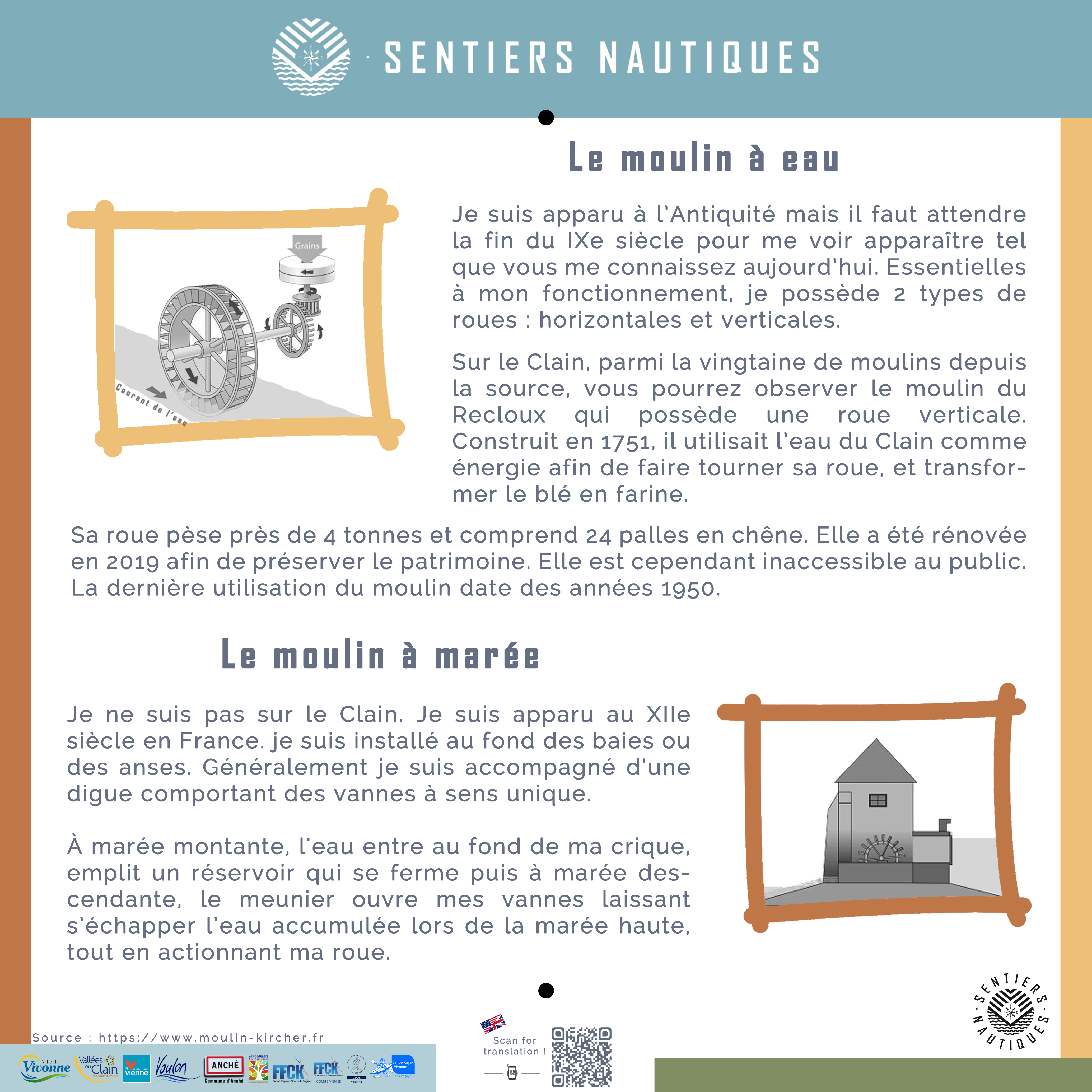
The watermill
I first appeared in antiquity but it wasn’t until the end of the 9th century that I became as you known me today. So that I can work effectively, I need 2 types of wheels: horizontal and vertical.
On the Clain, amongst the twenty mills from the source, you can see the Recloux’s mill which has a vertical wheel. Built in 1751, it used the water from the Clain as energy to turn its wheel and transform wheat into flour. Its wheel weighs close to 4 tons and has 24 oak paddles. It was renovated in 2019 as a heritage project. It is however inaccessible to the public. The mill was last used in the 1950s.
The tide mill
I’m not on the Clain, I appeared in the 12th century in France and I’m situated at the bottom of bays or coves. Usually, I am accompanied by a dike with one-way sluice gates. As the tide rises, water enters my creek and fills a tank that then closes. At low tide, the miller opens my sluice gates, letting the water accumulated during high tide escape and turn my wheel.
The coypu and the muskrat
Originally from South America, I was introduced into France at the end of the 19th century for the production of my fur. A semi-aquatic species, I frequent running, calm and stagnant waters, rich in aquatic vegetation. I dig a burrow in the banks or build a nest of dry grass.
The muskrat
Originally from North America, I was introduced in France in 1925. A few years later, I began to colonise the entire country. My habitat is similar to that of my cousin the coypu.
A puzzle to know more
The coypu and the muskrat are very close. However, they both have physical differences, especially their legs. Which drawing corresponds to the legs of the coypu and which one to its cousin the muskrat?
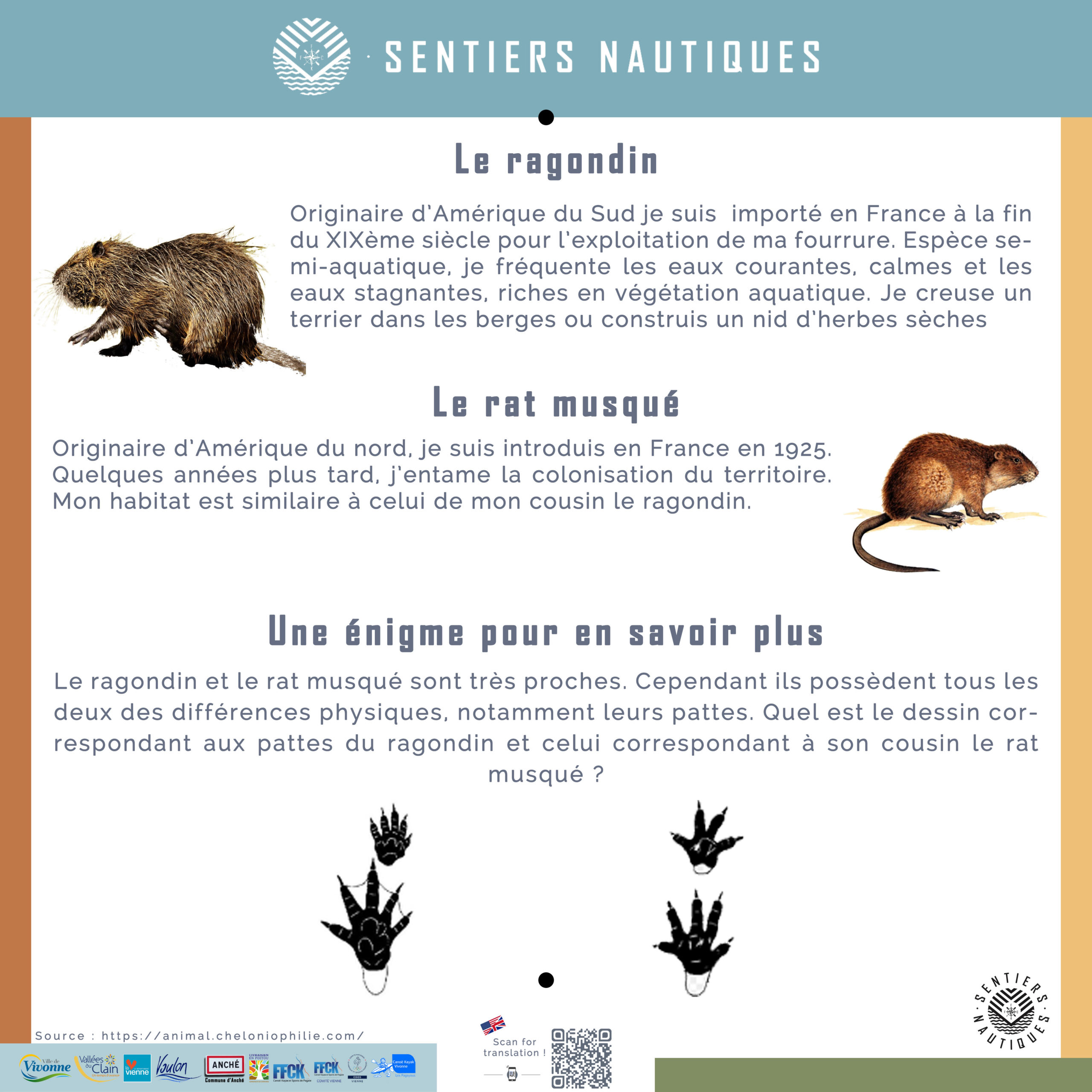
The coypu
I have webbed front legs with 5 fingers and long claws. My hind legs are also webbed but on 4 fingers leaving my 5th finger (external) independent.
Having a large profile, I have a coat of dark brown fur which is lighter on my belly. Despite their small size, my ears are well visible and my tail is cylindrical and not very hairy. Recognisable thanks to my orange-red incisors as an adult, I also have whiskers. The tip of my muzzle and my chin are white.
The muskrat
I have larger back legs than my front legs, they are also hairy, as well as being slightly webbed.
Darker than the coypu, my fur is dark brown and grayish on my belly, with a compact profile and small ears that are not very visible. My tail is flat sided, scaly, slightly hairy and blackish. My moustache is also dark. My incisors are yellow-orange as an adult but smaller than those of the coypu.
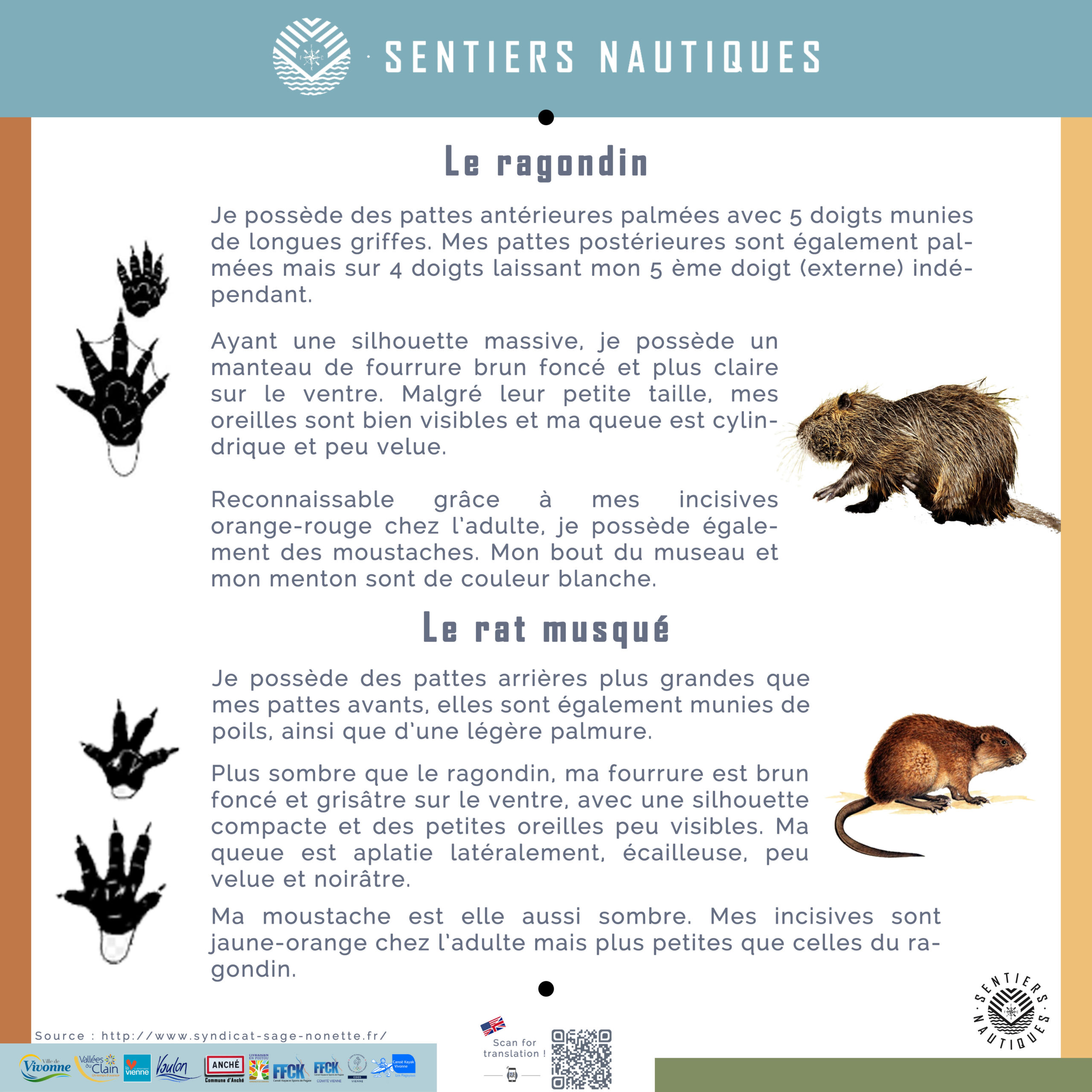
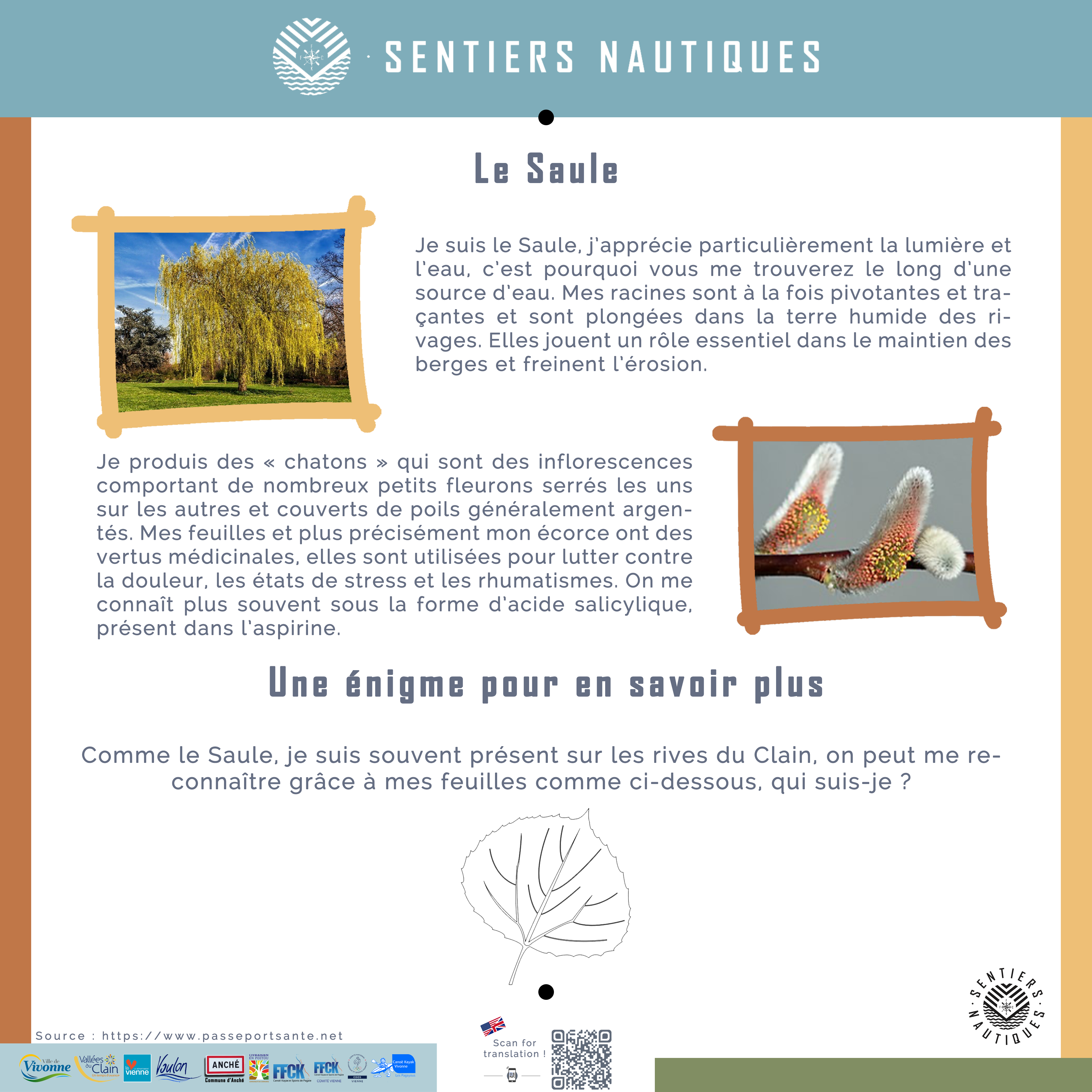
The willow tree
I am the willow, I particularly appreciate light and water, that’s why you will find me along a water course. The tracery of my roots penetrates deeply into the moist river banks. They play an essential role in maintaining the shoreline and curbing erosion.
I produce “catkins” which are bunches of small florets tightly packed together and covered with hair, usually silvery. My leaves, or more specifically my bark, have medicinal virtues, they are used to fight pain, stress and rheumatism. I am best known in the form of salicylic acid, present in aspirin.
A puzzle to find out more
Like the willow, I’m often present on the banks of the Clain, you can recognise me thanks to my leaves illustrated below, who am I?
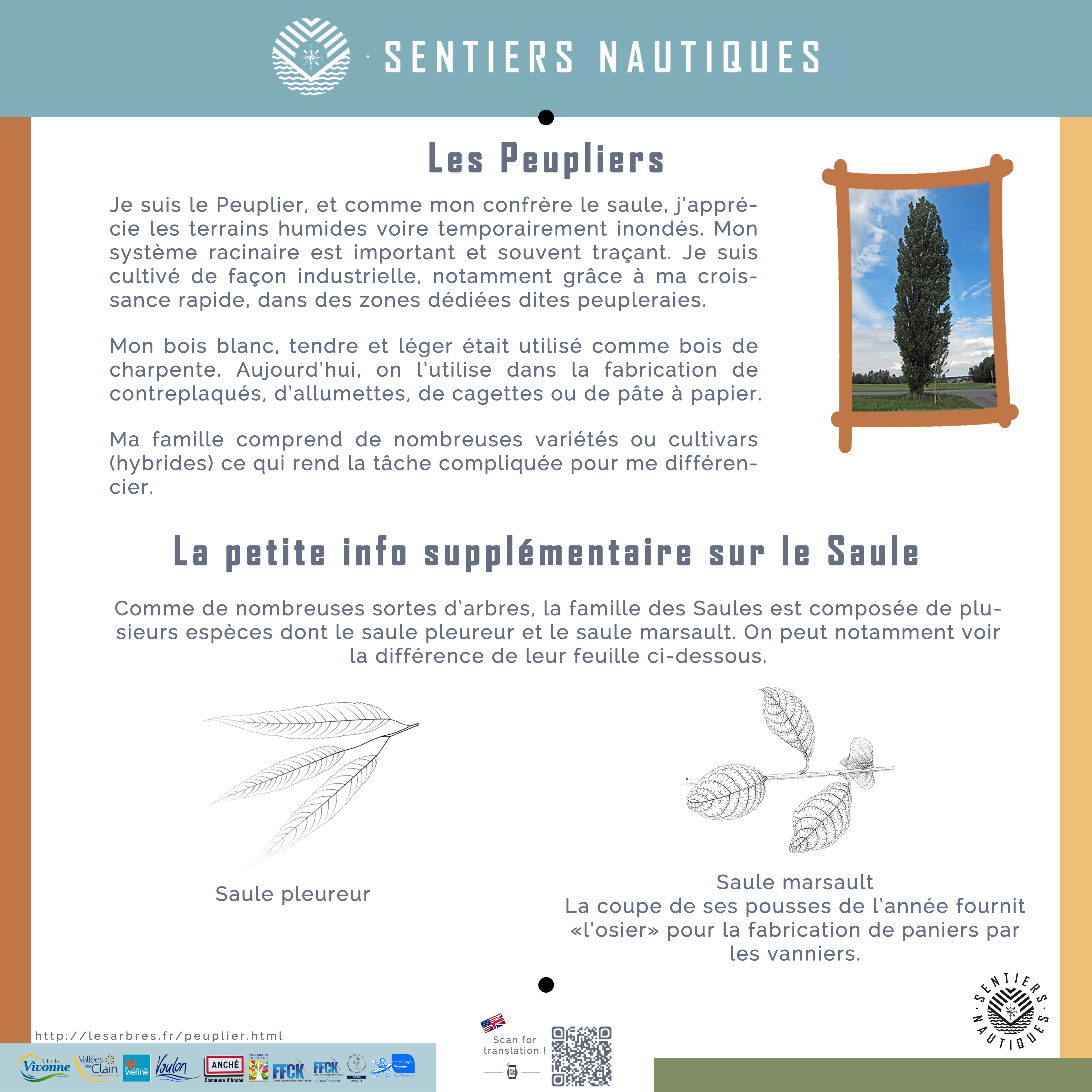
Poplars
I’m the poplar, and like my colleague the willow, I appreciate humid and even temporarily flooded ground. My root system is extensive and often with a delicate branching pattern like tracery. I’m cultivated industrially, in particular thanks to my rapid growth, in dedicated areas known as poplar groves.
My white wood, soft and light, was used as timber. Today, it is used in the manufacture of plywood, matches, crates or paper pulp.
My family includes many varieties or cultivars (hybrids) which makes it difficult to differentiate me.
A little extra info on the willow
Like many kinds of trees, the willow family is composed of several species including the weeping willow and the marchault willow. You can see the difference in their leaves below.
Weeping Willow
Marchault willow: the annual cutting of its shoots provides “wicker” for use by the basket maker in the manufacture of baskets.
Vivonne: a confluence giving witness to a rich past
Close to these islets, separated today by the railway, is the “Gentilommière de Jorigny” (17th century).
The name of the manor house and the park of Vounant is taken from the river Vonne, formerly known as the “Voune”.
It was the former owners bridleway before before being acquired by the commune of Vivonne.
The meanders of the Clain river pass by the last islets before joining the Vonne and they then widen together towards Poitiers. In addition, as early as 1539, there were plans to canalise the Clain and make it navigable from Vivonne to the Vienne downstream. This confluence is at the origin of the name Vivonne and contributed to its development and to the names of the great families associated with it.
Numerous mills were situated on its banks, the passage of goods over the bridges of the “Levée” generated income, but we know less about the existence of the “Bouchaulx” fisheries. Like the pigeon lofts, they were a source of income for the local lords and the dime (tax) for the bishopric. Discovered during construction work, one of these is located near the “Carmes” bridge, covered by the waters of the mill of the “Levée” on the Vonne.
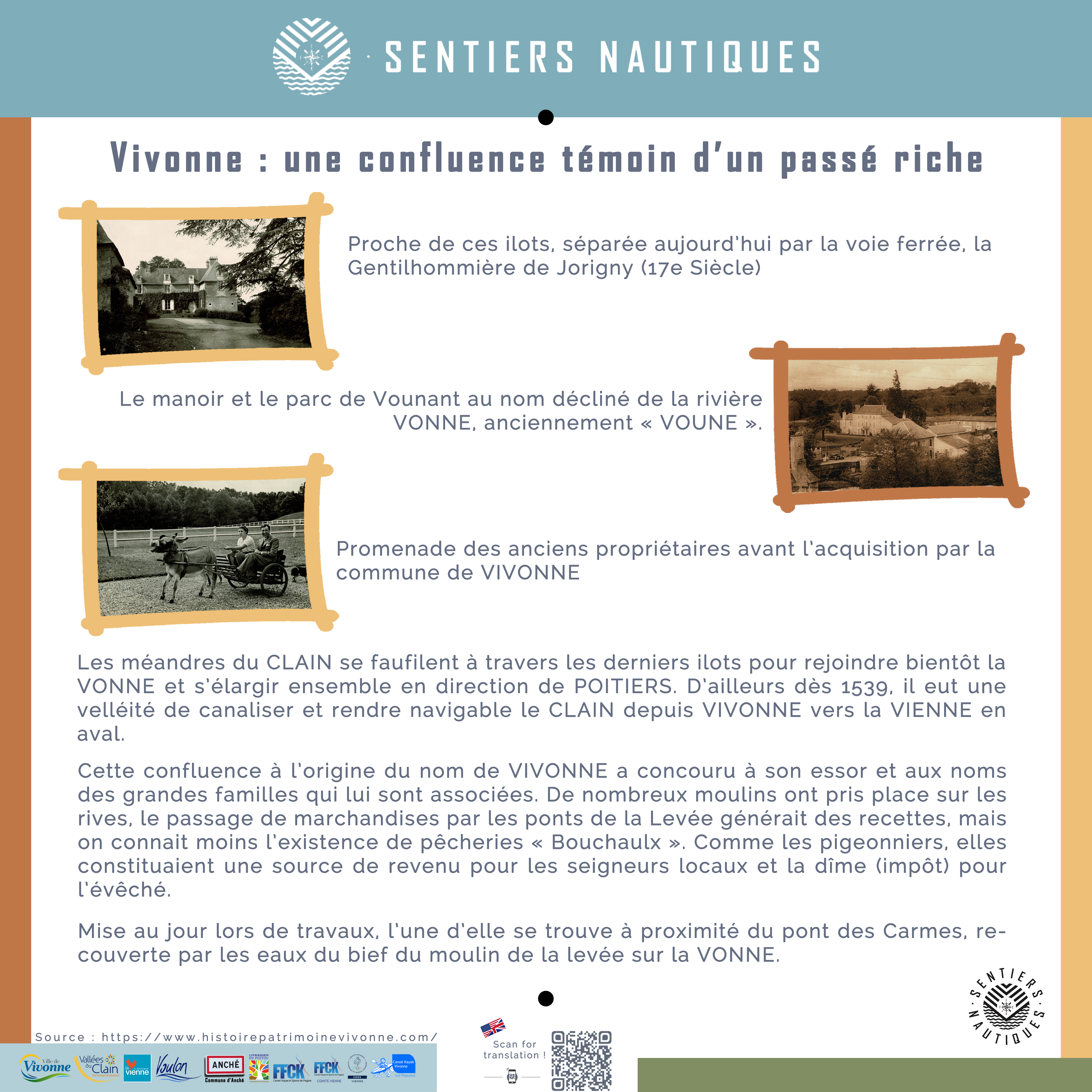
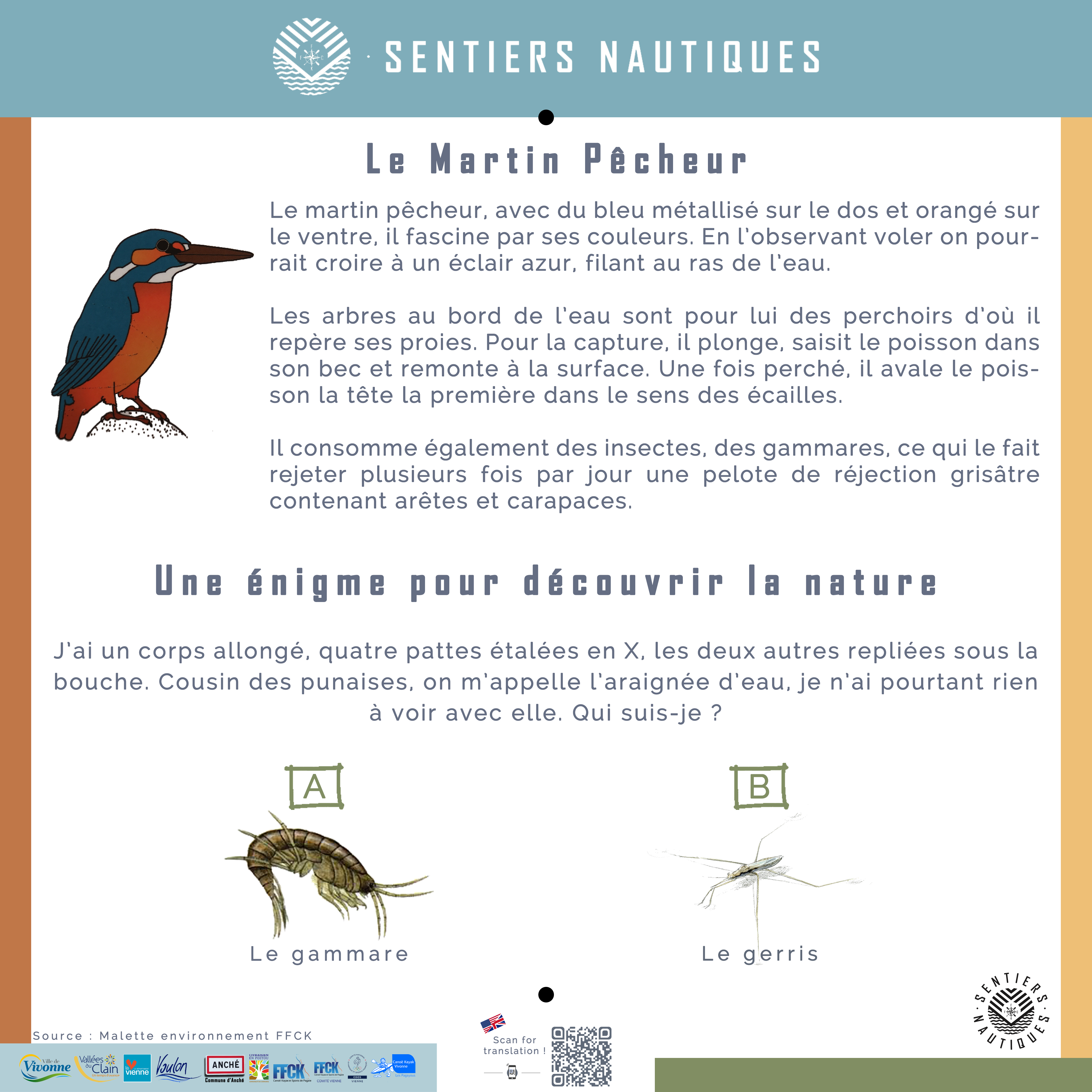
The kingfisher
The kingfisher, with metallic blue on its back and orange on its belly, fascinates us with its colours. Watching it fly, you might think it is a bright blue lightning bolt, flying at the water’s edge. For him, the trees at the water’s edge are perches from which he locates his prey. To catch his food, he dives, grabs the fish in his beak and rises to the surface. Once perched, he swallows the fish head first in the direction of the scales.
He also eats insects and freshwater shrimps, which means that several times a day he ejects a grayish ball of waste containing bones and shells.
A puzzle to discover nature
I have an elongated body, four legs spread out in an X form, the other two are folded under my mouth. Cousin of the bedbug, they call me the water spider, but I am not related to the spider. What am I?
A – A freshwater shrimp
B – A pond skater
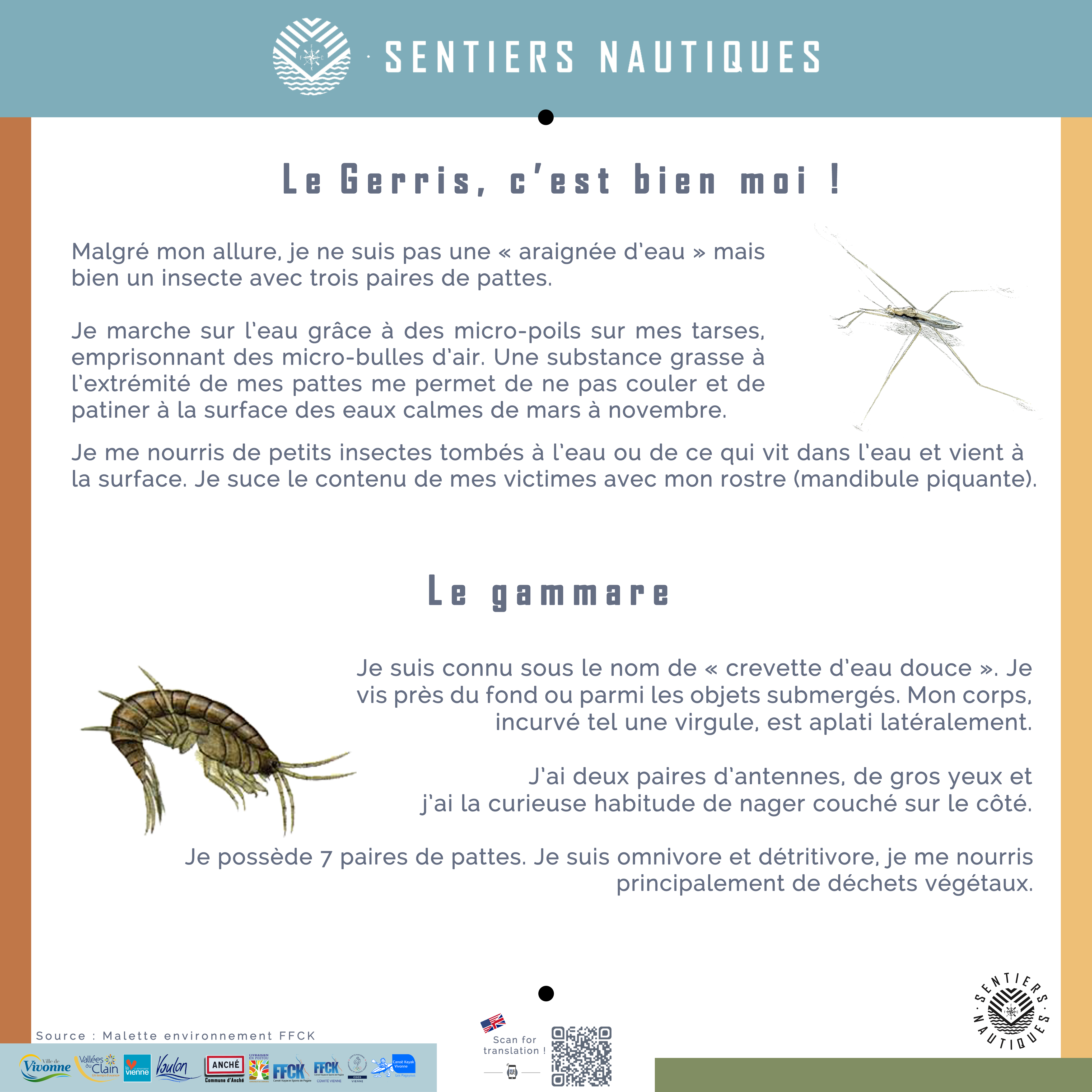
I am a pond skater!
In spite of my appearance, I’m not a “water spider” but an insect with three pairs of legs.
I walk on water thanks to micro hairs on my tarsals, trapping micro air bubbles. A greasy substance at the end of my feet prevents me from sinking and allows me to skate on the surface of calm waters from March to November.
I feed on small insects that have fallen into the water or on anything that lives in the water and comes to the surface. I suck the contents of my victims with my rostrum (sharp jaw).
I’m known as a “freshwater shrimp”
I live near the bottom or among submerged objects. My body, curved like a comma, is flat sided. I have two pairs of antennae, big eyes and the curious habit of swimming lying on my side. I have 7 pairs of legs. I’m omnivorous and a scavenger, since I feed mainly on vegetable waste.
